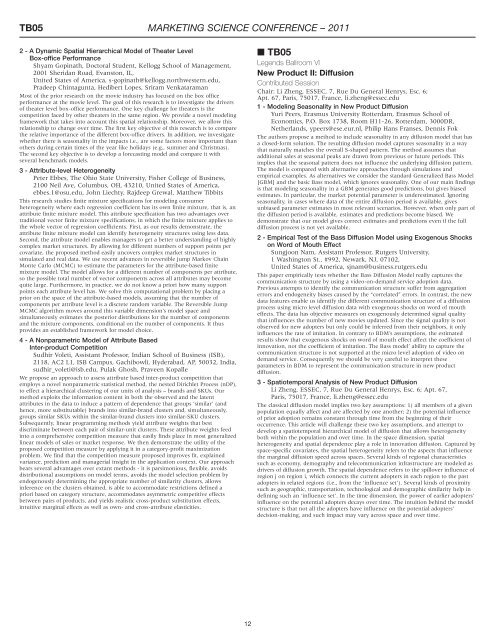Conference Sessions - Jesse H. Jones Graduate School of ...
Conference Sessions - Jesse H. Jones Graduate School of ...
Conference Sessions - Jesse H. Jones Graduate School of ...
Create successful ePaper yourself
Turn your PDF publications into a flip-book with our unique Google optimized e-Paper software.
TB05 MARKETING SCIENCE CONFERENCE – 2011<br />
2 - A Dynamic Spatial Hierarchical Model <strong>of</strong> Theater Level<br />
Box-<strong>of</strong>fice Performance<br />
Shyam Gopinath, Doctoral Student, Kellogg <strong>School</strong> <strong>of</strong> Management,<br />
2001 Sheridan Road, Evanston, IL,<br />
United States <strong>of</strong> America, s-gopinath@kellogg.northwestern.edu,<br />
Pradeep Chintagunta, Hedibert Lopes, Sriram Venkataraman<br />
Most <strong>of</strong> the prior research on the movie industry has focused on the box <strong>of</strong>fice<br />
performance at the movie level. The goal <strong>of</strong> this research is to investigate the drivers<br />
<strong>of</strong> theater level box-<strong>of</strong>fice performance. One key challenge for theaters is the<br />
competition faced by other theaters in the same region. We provide a novel modeling<br />
framework that takes into account this spatial relationship. Moreover, we allow this<br />
relationship to change over time. The first key objective <strong>of</strong> this research is to compare<br />
the relative importance <strong>of</strong> the different box-<strong>of</strong>fice drivers. In addition, we investigate<br />
whether there is seasonality in the impacts i.e., are some factors more important than<br />
others during certain times <strong>of</strong> the year like holidays (e.g., summer and Christmas).<br />
The second key objective is to develop a forecasting model and compare it with<br />
several benchmark models.<br />
3 - Attribute-level Heterogeneity<br />
Peter Ebbes, The Ohio State University, Fisher College <strong>of</strong> Business,<br />
2100 Neil Ave, Columbus, OH, 43210, United States <strong>of</strong> America,<br />
ebbes.1@osu.edu, John Liechty, Rajdeep Grewal, Matthew Tibbits<br />
This research studies finite mixture specifications for modeling consumer<br />
heterogeneity where each regression coefficient has its own finite mixture, that is, an<br />
attribute finite mixture model. This attribute specification has two advantages over<br />
traditional vector finite mixture specifications, in which the finite mixture applies to<br />
the whole vector <strong>of</strong> regression coefficients. First, as our results demonstrate, the<br />
attribute finite mixture model can identify heterogeneity structures using less data.<br />
Second, the attribute model enables managers to get a better understanding <strong>of</strong> highly<br />
complex market structures. By allowing for different numbers <strong>of</strong> support points per<br />
covariate, the proposed method easily uncovers complex market structures in<br />
simulated and real data. We use recent advances in reversible jump Markov Chain<br />
Monte Carlo (MCMC) to estimate the parameters for the attribute-based finite<br />
mixture model. The model allows for a different number <strong>of</strong> components per attribute,<br />
so the possible total number <strong>of</strong> vector components across all attributes may become<br />
quite large. Furthermore, in practice, we do not know a priori how many support<br />
points each attribute level has. We solve this computational problem by placing a<br />
prior on the space <strong>of</strong> the attribute-based models, assuming that the number <strong>of</strong><br />
components per attribute level is a discrete random variable. The Reversible Jump<br />
MCMC algorithm moves around this variable dimension’s model space and<br />
simultaneously estimates the posterior distributions for the number <strong>of</strong> components<br />
and the mixture components, conditional on the number <strong>of</strong> components. It thus<br />
provides an established framework for model choice.<br />
4 - A Nonparametric Model <strong>of</strong> Attribute Based<br />
Inter-product Competition<br />
Sudhir Voleti, Assistant Pr<strong>of</strong>essor, Indian <strong>School</strong> <strong>of</strong> Business (ISB),<br />
2118, AC2 L1, ISB Campus, Gachibowli, Hyderabad, AP, 50032, India,<br />
sudhir_voleti@isb.edu, Pulak Ghosh, Praveen Kopalle<br />
We propose an approach to assess attribute based inter-product competition that<br />
employs a novel nonparametric statistical method, the nested Dirichlet Process (nDP),<br />
to effect a hierarchical clustering <strong>of</strong> our units <strong>of</strong> analysis – brands and SKUs. Our<br />
method exploits the information content in both the observed and the latent<br />
attributes in the data to induce a pattern <strong>of</strong> dependence that groups ‘similar’ (and<br />
hence, more substitutable) brands into similar-brand clusters and, simultaneously,<br />
groups similar SKUs within the similar-brand clusters into similar-SKU clusters.<br />
Subsequently, linear programming methods yield attribute weights that best<br />
discriminate between each pair <strong>of</strong> similar-unit clusters. These attribute weights feed<br />
into a comprehensive competition measure that easily finds place in most generalized<br />
linear models <strong>of</strong> sales or market response. We then demonstrate the utility <strong>of</strong> the<br />
proposed competition measure by applying it in a category-pr<strong>of</strong>it maximization<br />
problem. We find that the competition measure proposed improves fit, explained<br />
variance, prediction and managerial insight in the application context. Our approach<br />
bears several advantages over extant methods - it is parsimonious, flexible, avoids<br />
distributional assumptions on model terms, avoids the model selection problem by<br />
endogenously determining the appropriate number <strong>of</strong> similarity clusters, allows<br />
inference on the clusters obtained, is able to accommodate restrictions defined a<br />
priori based on category structure, accommodates asymmetric competitive effects<br />
between pairs <strong>of</strong> products, and yields realistic cross-product substitution effects,<br />
intuitive marginal effects as well as own- and cross-attribute elasticities.<br />
12<br />
■ TB05<br />
Legends Ballroom VI<br />
New Product II: Diffusion<br />
Contributed Session<br />
Chair: Li Zheng, ESSEC, 7, Rue Du General Henrys, Esc. 6;<br />
Apt. 67, Paris, 75017, France, li.zheng@essec.edu<br />
1 - Modeling Seasonality in New Product Diffusion<br />
Yuri Peers, Erasmus University Rotterdam, Erasmus <strong>School</strong> <strong>of</strong><br />
Economics, P.O. Box 1738, Room H11-26, Rotterdam, 3000DR,<br />
Netherlands, ypeers@ese.eur.nl, Philip Hans Franses, Dennis Fok<br />
The authors propose a method to include seasonality in any diffusion model that has<br />
a closed-form solution. The resulting diffusion model captures seasonality in a way<br />
that naturally matches the overall S-shaped pattern. The method assumes that<br />
additional sales at seasonal peaks are drawn from previous or future periods. This<br />
implies that the seasonal pattern does not influence the underlying diffusion pattern.<br />
The model is compared with alternative approaches through simulations and<br />
empirical examples. As alternatives we consider the standard Generalized Bass Model<br />
[GBM] and the basic Bass model, which ignores seasonality. One <strong>of</strong> our main findings<br />
is that modeling seasonality in a GBM generates good predictions, but gives biased<br />
estimates. In particular, the market potential parameter is underestimated. Ignoring<br />
seasonality, in cases where data <strong>of</strong> the entire diffusion period is available, gives<br />
unbiased parameter estimates in most relevant scenarios. However, when only part <strong>of</strong><br />
the diffusion period is available, estimates and predictions become biased. We<br />
demonstrate that our model gives correct estimates and predictions even if the full<br />
diffusion process is not yet available.<br />
2 - Empirical Test <strong>of</strong> the Bass Diffusion Model using Exogenous Shocks<br />
on Word <strong>of</strong> Mouth Effect<br />
Sungjoon Nam, Assistant Pr<strong>of</strong>essor, Rutgers University,<br />
1 Washington St., #992, Newark, NJ, 07102,<br />
United States <strong>of</strong> America, sjnam@business.rutgers.edu<br />
This paper empirically tests whether the Bass Diffusion Model really captures the<br />
communication structure by using a video-on-demand service adoption data.<br />
Previous attempts to identify the communication structure suffer from aggregation<br />
errors and endogeneity biases caused by the “correlated” errors. In contrast, the new<br />
data features enable us identify the different communication structure <strong>of</strong> a diffusion<br />
process using micro level diffusion data with exogenous shocks on word <strong>of</strong> mouth<br />
effects. The data has objective measures on exogenously determined signal quality<br />
that influences the number <strong>of</strong> new movies updated. Since the signal quality is not<br />
observed for new adopters but only could be inferred from their neighbors, it only<br />
influences the rate <strong>of</strong> imitation. In contrary to BDM’s assumptions, the estimated<br />
results show that exogenous shocks on word <strong>of</strong> mouth effect affect the coefficient <strong>of</strong><br />
innovation, not the coefficient <strong>of</strong> imitation. The Bass model’ ability to capture the<br />
communication structure is not supported at the micro level adoption <strong>of</strong> video on<br />
demand service. Consequently we should be very careful to interpret these<br />
parameters in BDM to represent the communication structure in new product<br />
diffusion.<br />
3 - Spatiotemporal Analysis <strong>of</strong> New Product Diffusion<br />
Li Zheng, ESSEC, 7, Rue Du General Henrys, Esc. 6; Apt. 67,<br />
Paris, 75017, France, li.zheng@essec.edu<br />
The classical diffusion model implies two key assumptions: 1) all members <strong>of</strong> a given<br />
population equally affect and are affected by one another; 2) the potential influence<br />
<strong>of</strong> prior adoption remains constant through time from the beginning <strong>of</strong> their<br />
occurrence. This article will challenge these two key assumptions, and attempt to<br />
develop a spatiotemporal hierarchical model <strong>of</strong> diffusion that allows heterogeneity<br />
both within the population and over time. In the space dimension, spatial<br />
heterogeneity and spatial dependence play a role in innovation diffusion. Captured by<br />
space-specific covariates, the spatial heterogeneity refers to the aspects that influence<br />
the marginal diffusion speed across spaces. Several kinds <strong>of</strong> regional characteristics<br />
such as economy, demography and telecommunication infrastructure are modeled as<br />
drivers <strong>of</strong> diffusion growth. The spatial dependence refers to the spillover influence <strong>of</strong><br />
region j on region i, which connects the current adopters in each region to the past<br />
adopters in related regions (i.e., from the ‘influence set’). Several kinds <strong>of</strong> proximity<br />
such as geographic, transportation, technological and demographic similarity help in<br />
defining such an ‘influence set’. In the time dimension, the power <strong>of</strong> earlier adopters’<br />
influence on the potential adopters decays over time. The intuition behind the model<br />
structure is that not all the adopters have influence on the potential adopters’<br />
decision-making, and such impact may vary across space and over time.

















